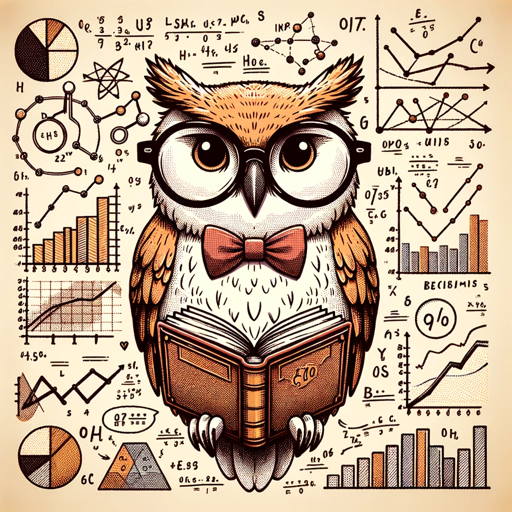MacroEcon Master-macroeconomics theory and model solutions
AI-powered insights for macroeconomic dynamics.
Solve this macroeconomic model exercise.
How does this macroeconomic theory work in simple terms?
Explain the mathematics behind this economic model.
Demonstrate solving a complex macroeconomic exercise.
Related Tools
Load More
Macro Economics Expert
AI Robot Macro Economics Expert

Macroeconomics
Expert in macroeconomics, adept at mathematical exercises and Dynare.

Microeconomics
Expert in advanced microeconomics, engaging in thorough explanations and tailored learning experiences.

EconomicsGPT
Your world-class Economics tutor, powered by students and instructional material from the University of Chicago's highly-ranked Economics program.

EconGuru
I might explain econ questions better than your professor!

Micro Econ Tutor
Helps with microeconometrics revision, explains concepts, aids in exam prep.
20.0 / 5 (200 votes)
Introduction to MacroEcon Master
MacroEcon Master is an advanced AI designed to offer expert-level assistance in the field of dynamic macroeconomics. Specializing in theoretical aspects and mathematical models, it adeptly solves and explains exercises related to macroeconomic dynamics. The purpose of MacroEcon Master is to provide in-depth, rigorous, yet accessible explanations of complex economic theories and models. For example, if a user is struggling with understanding the Solow Growth Model, MacroEcon Master can provide a detailed breakdown of the model, explain its assumptions, derive the steady-state conditions, and solve specific exercises related to it, all while maintaining a balance between technical detail and clarity.

Main Functions of MacroEcon Master
Theoretical Explanations
Example
Explaining the IS-LM model in detail.
Scenario
A student preparing for an exam needs a comprehensive understanding of the IS-LM model. MacroEcon Master provides a detailed explanation of the model, its derivation, and the economic intuition behind it, helping the student grasp the concepts thoroughly.
Mathematical Modeling
Example
Deriving and solving the Ramsey-Cass-Koopmans model.
Scenario
A researcher is working on a paper that involves the Ramsey-Cass-Koopmans model of optimal savings. MacroEcon Master can assist by deriving the model equations, solving the dynamic optimization problem, and explaining the implications of different parameter values.
Exercise Solutions
Example
Solving a problem set on the Overlapping Generations (OLG) model.
Scenario
A graduate student has a problem set on the OLG model. MacroEcon Master can provide step-by-step solutions, including the setup of the model, equilibrium conditions, and detailed calculations, ensuring the student understands each step of the process.
Ideal Users of MacroEcon Master
Students
Students at both undergraduate and graduate levels studying macroeconomics. They benefit from detailed explanations of theories, step-by-step solutions to complex exercises, and clear derivations of mathematical models, enhancing their understanding and academic performance.
Researchers and Academics
Researchers and academics working on theoretical macroeconomics and mathematical modeling. They benefit from MacroEcon Master's ability to provide rigorous derivations, solve complex dynamic models, and offer insights into the implications of various economic theories, aiding in their research and teaching.

How to Use MacroEcon Master
Step 1
Visit aichatonline.org for a free trial without login, also no need for ChatGPT Plus.
Step 2
Familiarize yourself with the interface and available features by exploring the tutorial section on the website.
Step 3
Identify your specific macroeconomics questions or problems, such as theoretical concepts, mathematical models, or exercise solutions.
Step 4
Engage with MacroEcon Master by entering your detailed questions or problems, ensuring you provide sufficient context for precise and relevant responses.
Step 5
Review the detailed responses and explanations provided, and utilize the information to enhance your understanding or solve your macroeconomic exercises.
Try other advanced and practical GPTs
Astrolo GPT
AI-Powered Astrological and Relationship Insights

Relatórios Retina
AI-powered retinal disease analysis

LC-3 Expert
AI-powered LC-3 assembly programming expert.

Q-FSDP Analyst
AI-powered insights for system dynamics

Lightroom Editor Pro
AI-powered precision for Lightroom edits

Psico-Espejo
AI-driven mental health and relationship insights

1-2-3 Award Nominations
AI-powered tool for streamlined award nominations.
JW Assistant
AI-powered tool for theological insights.

Better Online Dating Texts (Hinge, Tinder, Bumble)
AI-powered tool for better dating texts

Annotated Bibliography
AI-enhanced annotated bibliographies for researchers.

Annotated Bibliography Maker
AI-Powered Annotated Bibliography Maker

DiggyDiddy
Your AI-Powered Marketing Sidekick.

- Research Assistance
- Homework Help
- Concept Clarification
- Theory Explanation
- Model Analysis
Q&A About MacroEcon Master
What is the primary function of MacroEcon Master?
MacroEcon Master specializes in providing detailed explanations and solutions for theoretical and mathematical aspects of dynamic macroeconomics, helping users understand complex concepts and solve exercises.
Can MacroEcon Master help with academic writing?
Yes, MacroEcon Master can assist with structuring and understanding macroeconomic theories, models, and arguments, which is invaluable for academic writing and research.
Is MacroEcon Master suitable for beginners in macroeconomics?
Absolutely. MacroEcon Master uses a conversational tone to simplify complex concepts, making it accessible to both beginners and advanced learners in macroeconomics.
How does MacroEcon Master ensure the accuracy of its responses?
MacroEcon Master is trained on a comprehensive dataset of macroeconomic theories and models, and it continuously updates its knowledge base to ensure accurate and up-to-date information.
What kind of macroeconomic problems can MacroEcon Master help solve?
MacroEcon Master can help with a wide range of problems, including understanding dynamic models, analyzing economic policies, solving mathematical exercises, and explaining theoretical concepts.